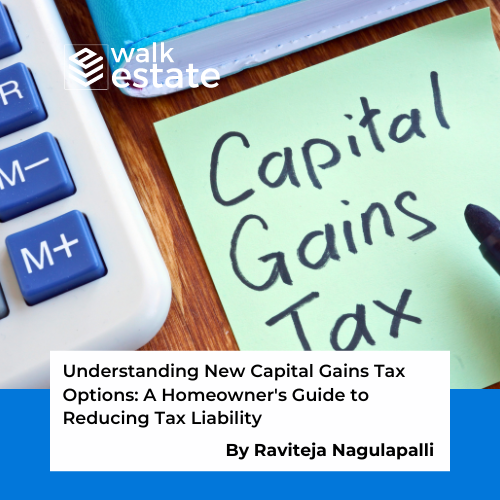Table of Contents
Understanding Capital Gains Tax
Capital gains tax is a crucial consideration for anyone selling an asset, particularly homeowners. Recent changes in how this tax is calculated have the potential to offer significant relief, especially for those selling real estate. This article delves into what these changes entail, how they impact homeowners, and what strategies can be employed to minimize tax liability.
What is Capital Gains Tax?
Capital gains tax (CGT) is a tax on the profit earned from the sale of an asset. In the context of real estate, this typically applies to the sale of property, where the gain is the difference between the purchase price and the sale price.
Types of Capital Gains
Capital gains are categorized into two types:
- Short-Term Capital Gains (STCG): These are profits from assets held for a short duration (usually less than three years). The tax on STCG is typically higher, as it is taxed at the individual’s income tax slab rate.
- Long-Term Capital Gains (LTCG): Profits from assets held for a longer period (more than three years) fall under LTCG. This tax is usually lower, and different rules, such as indexation benefits, apply.
Short-Term vs. Long-Term Capital Gains
The main difference between short-term and long-term capital gains lies in the duration for which the asset is held and the tax rates applied. STCG is taxed at a higher rate because the profit is considered as part of the individual’s regular income. LTCG, on the other hand, is taxed at a lower rate, acknowledging the long-term nature of the investment.
Recent Changes in Real estate Capital Gains Tax
Recently, the Indian government introduced new rules regarding LTCG tax for real estate transactions. The changes offer two options for homeowners:
- A flat 12.5% LTCG tax without indexation benefits.
- A 20% LTCG tax with indexation benefits.
The 12.5% LTCG Tax Option
This option introduces a flat tax rate of 12.5% on long-term capital gains, without allowing any adjustment for inflation (indexation). This lower rate can be particularly beneficial for those who have owned their property for a shorter duration, as it simplifies the tax calculation and potentially lowers the overall tax burden.
The 20% Tax with Indexation
The 20% LTCG tax rate includes the benefit of indexation, which adjusts the purchase price of the property to account for inflation. This adjustment can significantly reduce the taxable gain, making this option favorable for those who have held their property for a longer period.
Impact on Homeowners
These changes are designed to reduce the tax liability for homeowners and provide more flexibility in managing their financial outcomes from property sales.
How the Changes Benefit Homeowners
For homeowners, these options allow for more strategic decision-making. For instance, someone selling a property that has appreciated significantly over a long period might opt for the 20% tax with indexation to minimize taxable gains. Conversely, those looking to sell a property held for a shorter time might find the 12.5% flat rate more advantageous.
Comparing the Two Options
Choosing between the two options depends on various factors, including how long the property has been held, the rate of inflation during that period, and the homeowner’s broader financial situation.
Which Option to Choose?
Selecting the best option requires careful consideration. Homeowners should evaluate their specific circumstances, including the property’s holding period, expected profit, and future financial goals. Consulting a tax professional can be helpful in making an informed decision.
Tax Planning Strategies for Homeowners
With these new tax options, homeowners can employ various strategies to optimize their tax outcomes. For instance, they might consider timing the sale of their property to benefit from lower tax rates or strategically using indexation to reduce taxable gains.
Importance of Professional Advice
Given the complexities involved in capital gains tax calculations, seeking professional advice is advisable. A tax advisor can help homeowners navigate the new rules and identify the most tax-efficient strategies for their situation.
Future Outlook
While the recent changes are beneficial, the future of capital gains tax in India could see further adjustments. Homeowners should stay informed about potential changes and be prepared to adapt their strategies accordingly.
Conclusion
The recent adjustments to capital gains tax calculations represent a significant relief for homeowners, offering more options and potentially lower tax liabilities. By understanding these changes and seeking professional advice, homeowners can make informed decisions that align with their financial goals.
FAQ’s
What is the difference between 12.5% LTCG tax and 20% with indexation?
The 12.5% LTCG tax is a flat rate without indexation benefits, while the 20% rate allows for inflation adjustment, which can reduce taxable gains.
Who benefits the most from the new tax options?
Homeowners with properties held for varying durations can benefit, depending on whether they prefer a simpler flat tax or the advantages of indexation.
How does indexation work?
Indexation adjusts the purchase price of the property based on inflation, reducing the capital gain and, consequently, the tax liability.
Can these changes affect property values?
While the tax changes primarily affect sellers, they could influence market behavior and indirectly impact property values.
What should homeowners do now?
Homeowners should assess their current situation, consider the new tax options, and consult with a tax professional to determine the best course of action.




